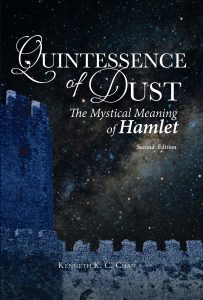by Kenneth Chan
A Foreword Magazine’s Book of the Year Award Finalist
with Honorable Mention
 Shakespeare’s Hamlet contains a profound spiritual message for mankind that has been largely unrecognized for centuries. The meaning of Hamlet so perplexed critics over the last four hundred years that many finally concluded, after immense struggle, that the play lacks a binding philosophy. Nothing, in fact, is more wrong.
Shakespeare’s Hamlet contains a profound spiritual message for mankind that has been largely unrecognized for centuries. The meaning of Hamlet so perplexed critics over the last four hundred years that many finally concluded, after immense struggle, that the play lacks a binding philosophy. Nothing, in fact, is more wrong.
Quintessence of Dust now explains how Shakespeare meticulously crafted every scene to convey, through our emotional involvement in the drama, a central spiritual message. The book also explains by a single coherent theme practically every aspect of the play that has puzzled critics for centuries, including the following:
- the reason for Hamlet’s delay in exacting his revenge;
- why Hamlet himself is unsure why he delays;
- the purpose of the long swearing ritual at the end of Act I;
- the reason for Polonius’s long dialogue with Reynaldo;
- why the status of Hamlet’s madness is ambiguous;
- the purpose of the long dramatic recitation on Pyrrhus;
- the reason for Hamlet’s savage treatment of Ophelia;
- the meaning of the “To Be” soliloquy;
- the reason for Hamlet’s advice (on acting) to the players;
- why the King does not react to the dumb show;
- why Hamlet lacks remorse after accidentally killing Polonius;
- the meaning behind the nature of Ophelia’s death;
- the purpose of the long graveyard scene;
- why Hamlet grapples in fury with Laertes at the gravesite;
- the purpose of the prolonged dialogue with Osric;
- the meaning behind the final duel scene;
- why each of the characters died in the particular way they did.
All these, and more, are shown to be artistic means of imparting the central message of the play. It demonstrates that Hamlet is nothing short of an artistic miracle, reflected both in its poetic brilliance and in its profound meaning.
Quintessence of Dust: The Mystical Meaning of Hamlet 2nd Edition (Amazon site)
See also The Mystical Art of Shakespeare Volume I: The Meaning of Much Ado About Nothing & The Comedy of Errors and The Mystical Art of Shakespeare Volume II: The Meaning of The Taming of the Shrew & Romeo and Juliet.
Articles
The Mystical Art of Shakespeare
The transcendent light that burns within the text of a Shakespearean play is conveyed to us, in true mystical fashion, by absorbing our very being into the enactment of its meaning. The message of the play is not conveyed intellectually; it is experienced. The mystical art of Shakespeare is thus the art of initiation. Shakespeare conveys his meaning by making us live through it.
This chapter also presents the three unique techniques that Shakespeare employs to convey his meaning: Cohesive Unity, Thematic Resonance and Focused Allegorical Scenes. Read more …
Why Hamlet Delays His Revenge
The reason for Hamlet’s delay has haunted critics for four centuries. Different authors have presented differing reasons for the delay, which, in itself, raises another question concerning this puzzling aspect of the play: Why does Shakespeare give so much prominence to the delay without clearly presenting the reason for it? The answer helps point us toward Shakespeare’s own reason for Hamlet’s delay.
The Meaning Behind the Dialogue Between Polonius and Reynaldo in Hamlet
Why does Shakespeare dwell so much on this dialogue, especially since we never hear of Reynaldo, or what he did with the instructions to spy on Laertes, ever again? This paper reveals that Shakespeare actually crafts the dialogue to convey a profound message – a message that resonates through the entire play to reach a thundering climax at the final duel scene.
How Shakespeare Conveys His Meaning through Cohesive Unity, Focused Allegorical Scenes, and Thematic Resonance
How Shakespeare makes use of these three techniques to convey the deep meaning in Hamlet: Cohesive unity, focused allegorical scenes, and thematic resonance. They provide overwhelming evidence for Shakespeare’s authorial intent in meticulously crafting Hamlet to convey a profound message.
Discussions
Discussions at The Official William Shakespeare Page:
The Meaning Behind the Dialogue Between Polonius and Reynaldo in Hamlet